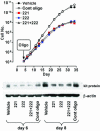MicroRNAs 221 and 222 inhibit normal erythropoiesis and erythroleukemic cell growth via kit receptor down-modulation
- PMID: 16330772
- PMCID: PMC1312381
- DOI: 10.1073/pnas.0506216102
MicroRNAs 221 and 222 inhibit normal erythropoiesis and erythroleukemic cell growth via kit receptor down-modulation
Abstract
MicroRNAs (miRs) are small noncoding RNAs that regulate gene expression primarily through translational repression. In erythropoietic (E) culture of cord blood CD34+ progenitor cells, the level of miR 221 and 222 is gradually and sharply down-modulated. Hypothetically, this decline could promote erythropoiesis by unblocking expression of key functional proteins. Indeed, (i) bioinformatic analysis suggested that miR 221 and 222 target the 3' UTR of kit mRNA; (ii) the luciferase assay confirmed that both miRs directly interact with the kit mRNA target site; and (iii) in E culture undergoing exponential cell growth, miR down-modulation is inversely related to increasing kit protein expression, whereas the kit mRNA level is relatively stable. Functional studies show that treatment of CD34+ progenitors with miR 221 and 222, via oligonucleotide transfection or lentiviral vector infection, causes impaired proliferation and accelerated differentiation of E cells, coupled with down-modulation of kit protein: this phenomenon, observed in E culture releasing endogenous kit ligand, is magnified in E culture supplemented with kit ligand. Furthermore, transplantation experiments in NOD-SCID mice reveal that miR 221 and 222 treatment of CD34+ cells impairs their engraftment capacity and stem cell activity. Finally, miR 221 and 222 gene transfer impairs proliferation of the kit+ TF-1 erythroleukemic cell line. Altogether, our studies indicate that the decline of miR 221 and 222 during exponential E growth unblocks kit protein production at mRNA level, thus leading to expansion of early erythroblasts. Furthermore, the results on kit+ erythroleukemic cells suggest a potential role of these miRs in cancer therapy.
Figures





Similar articles
-
PLZF-mediated control on c-kit expression in CD34(+) cells and early erythropoiesis.Oncogene. 2009 Jun 11;28(23):2276-88. doi: 10.1038/onc.2009.87. Epub 2009 May 4. Oncogene. 2009. PMID: 19421145
-
miR-22 Inhibits CD34+ Cell Expansion Through Decreasing β-Catenin in Osteoblasts.Hum Gene Ther. 2017 Jan;28(1):135-145. doi: 10.1089/hum.2016.104. Epub 2016 Sep 19. Hum Gene Ther. 2017. PMID: 27762627
-
Mechanism of human Hb switching: a possible role of the kit receptor/miR 221-222 complex.Haematologica. 2010 Aug;95(8):1253-60. doi: 10.3324/haematol.2009.018259. Epub 2010 Mar 19. Haematologica. 2010. PMID: 20305142 Free PMC article.
-
Regulation of the MIR155 host gene in physiological and pathological processes.Gene. 2013 Dec 10;532(1):1-12. doi: 10.1016/j.gene.2012.12.009. Epub 2012 Dec 14. Gene. 2013. PMID: 23246696 Review.
-
Role of Tat-interacting protein of 110 kDa and microRNAs in the regulation of hematopoiesis.Curr Opin Hematol. 2016 Jul;23(4):325-30. doi: 10.1097/MOH.0000000000000246. Curr Opin Hematol. 2016. PMID: 27071021 Review.
Cited by
-
A novel onco-miR-365 induces cutaneous squamous cell carcinoma.Carcinogenesis. 2013 Jul;34(7):1653-9. doi: 10.1093/carcin/bgt097. Epub 2013 Mar 20. Carcinogenesis. 2013. PMID: 23514750 Free PMC article.
-
Growth inhibitory effects of miR-221 and miR-222 in non-small cell lung cancer cells.Cancer Med. 2015 Apr;4(4):551-64. doi: 10.1002/cam4.412. Epub 2015 Jan 30. Cancer Med. 2015. PMID: 25641933 Free PMC article.
-
Increase of microRNA-210, decrease of raptor gene expression and alteration of mammalian target of rapamycin regulated proteins following mithramycin treatment of human erythroid cells.PLoS One. 2015 Apr 7;10(4):e0121567. doi: 10.1371/journal.pone.0121567. eCollection 2015. PLoS One. 2015. PMID: 25849663 Free PMC article.
-
microRNAs: fine tuning of erythropoiesis.Cell Mol Biol Lett. 2013 Mar;18(1):34-46. doi: 10.2478/s11658-012-0038-z. Epub 2012 Nov 3. Cell Mol Biol Lett. 2013. PMID: 23124859 Free PMC article. Review.
-
MicroRNA-584 functions as a tumor suppressor and targets PTTG1IP in glioma.Int J Clin Exp Pathol. 2014 Dec 1;7(12):8573-82. eCollection 2014. Int J Clin Exp Pathol. 2014. PMID: 25674221 Free PMC article.
References
-
- Bartel, D. P. (2004) Cell 116, 281-297. - PubMed
-
- Lee, Y., Ahn, C., Han, J., Choi, H., Kim, J., Yim, J., Lee, J., Provost, P., Radmark, O., Kim, S., et al. (2003) Nature 425, 415-419. - PubMed
-
- Ambros, V. (2004) Nature 431, 350-355. - PubMed
-
- Yekta, S., Shih, I. H. & Bartel, D. P. (2004) Science 304, 594-596. - PubMed
Publication types
MeSH terms
Substances
Grants and funding
LinkOut - more resources
Full Text Sources
Other Literature Sources
Medical
Molecular Biology Databases
Miscellaneous

